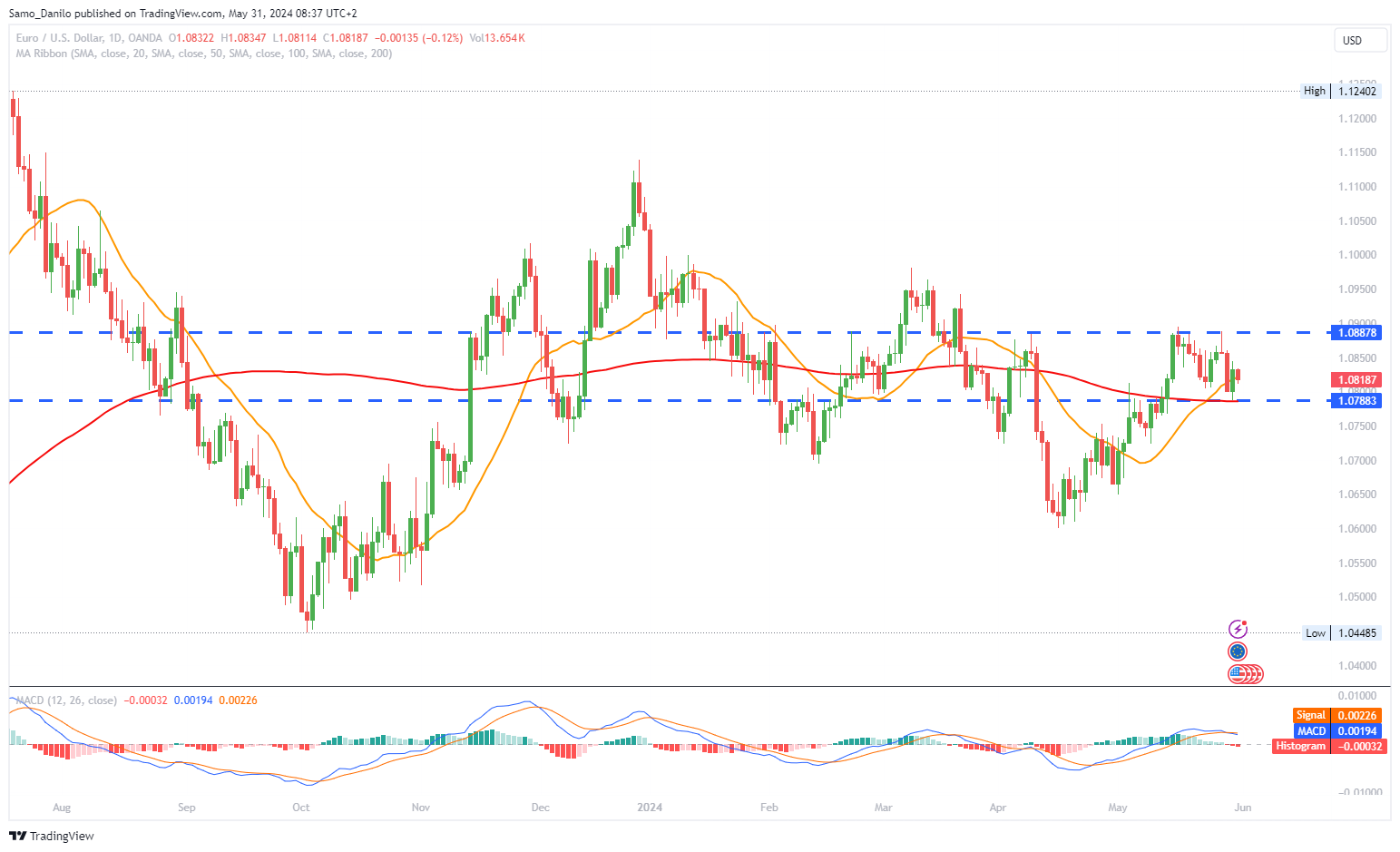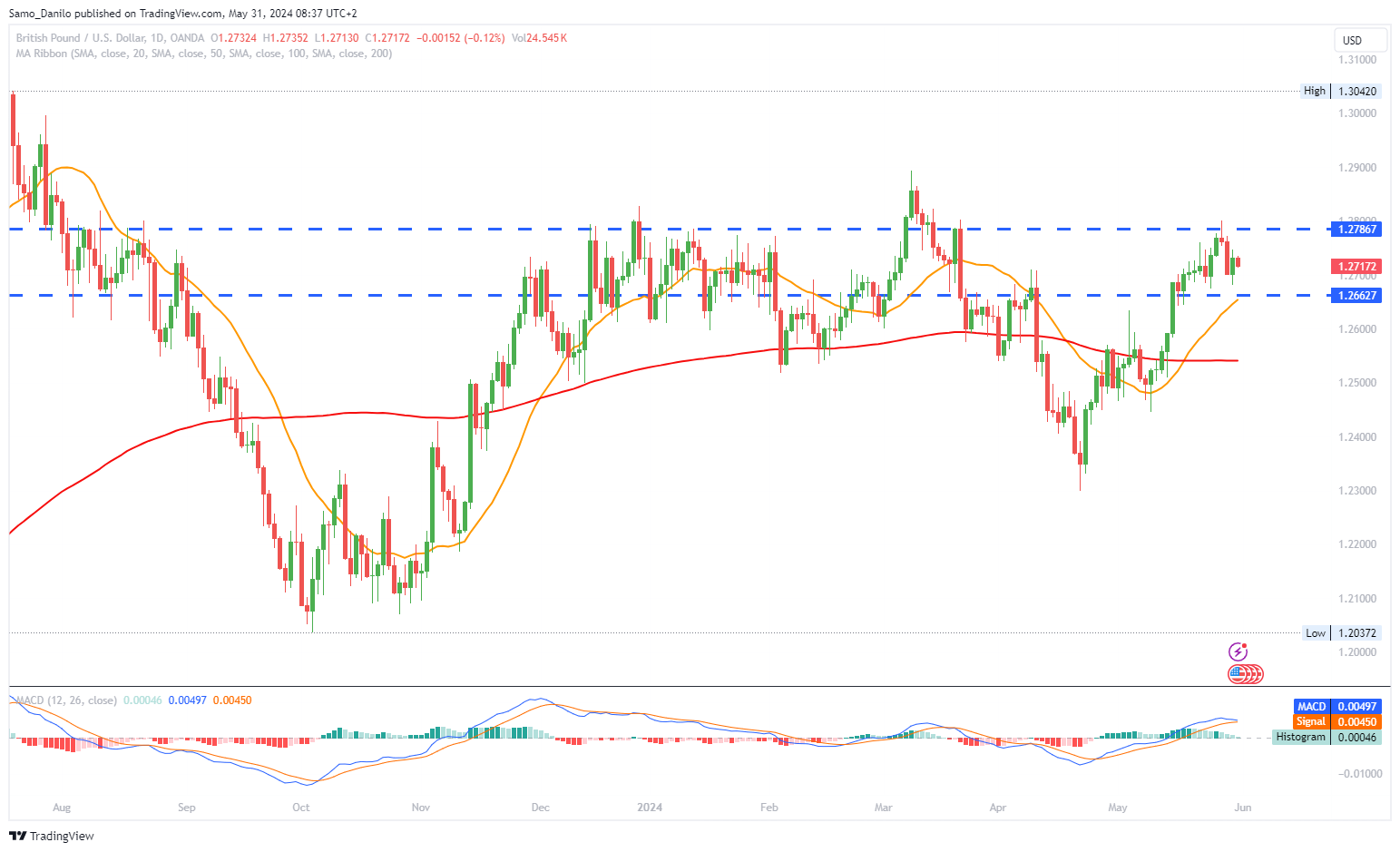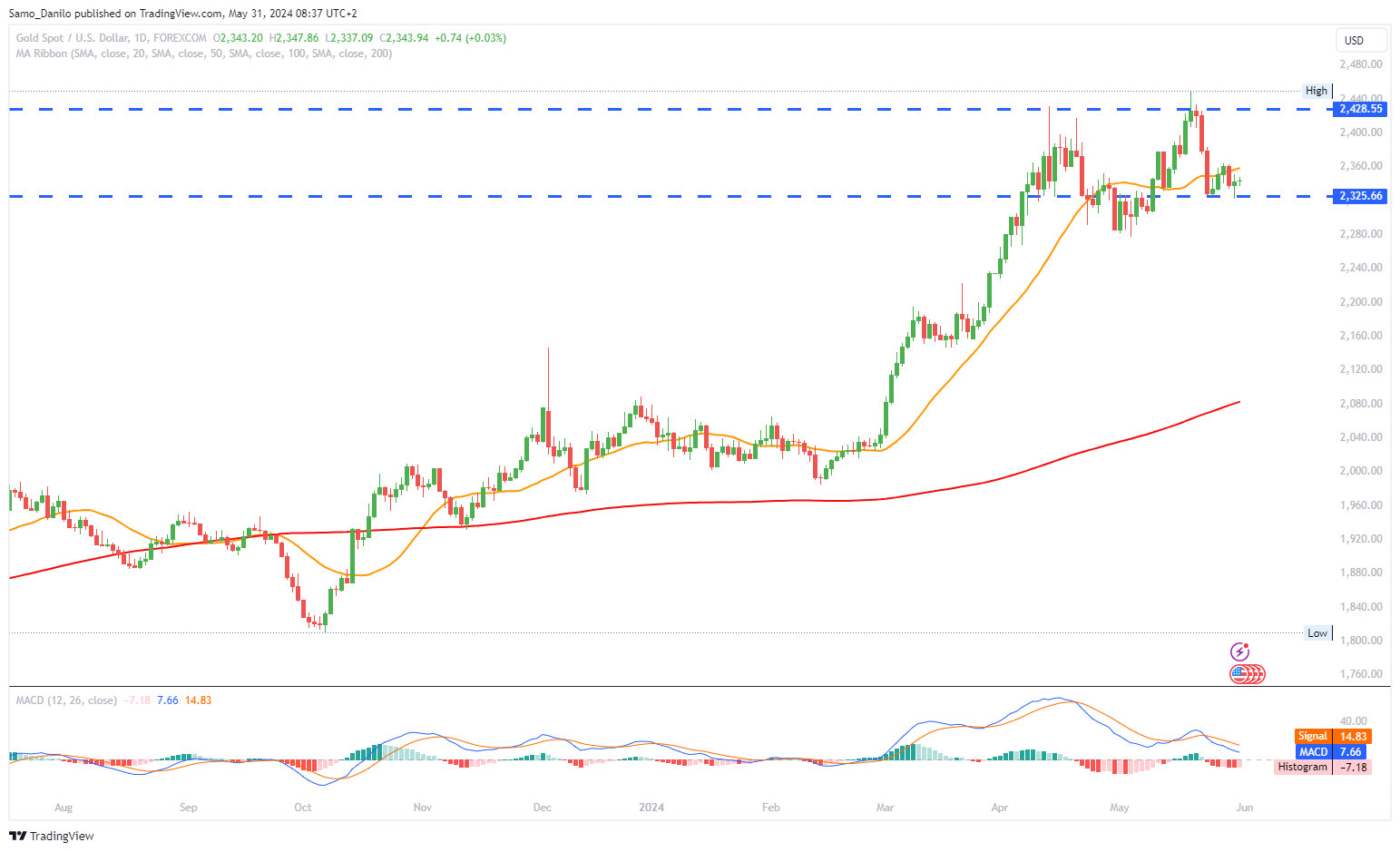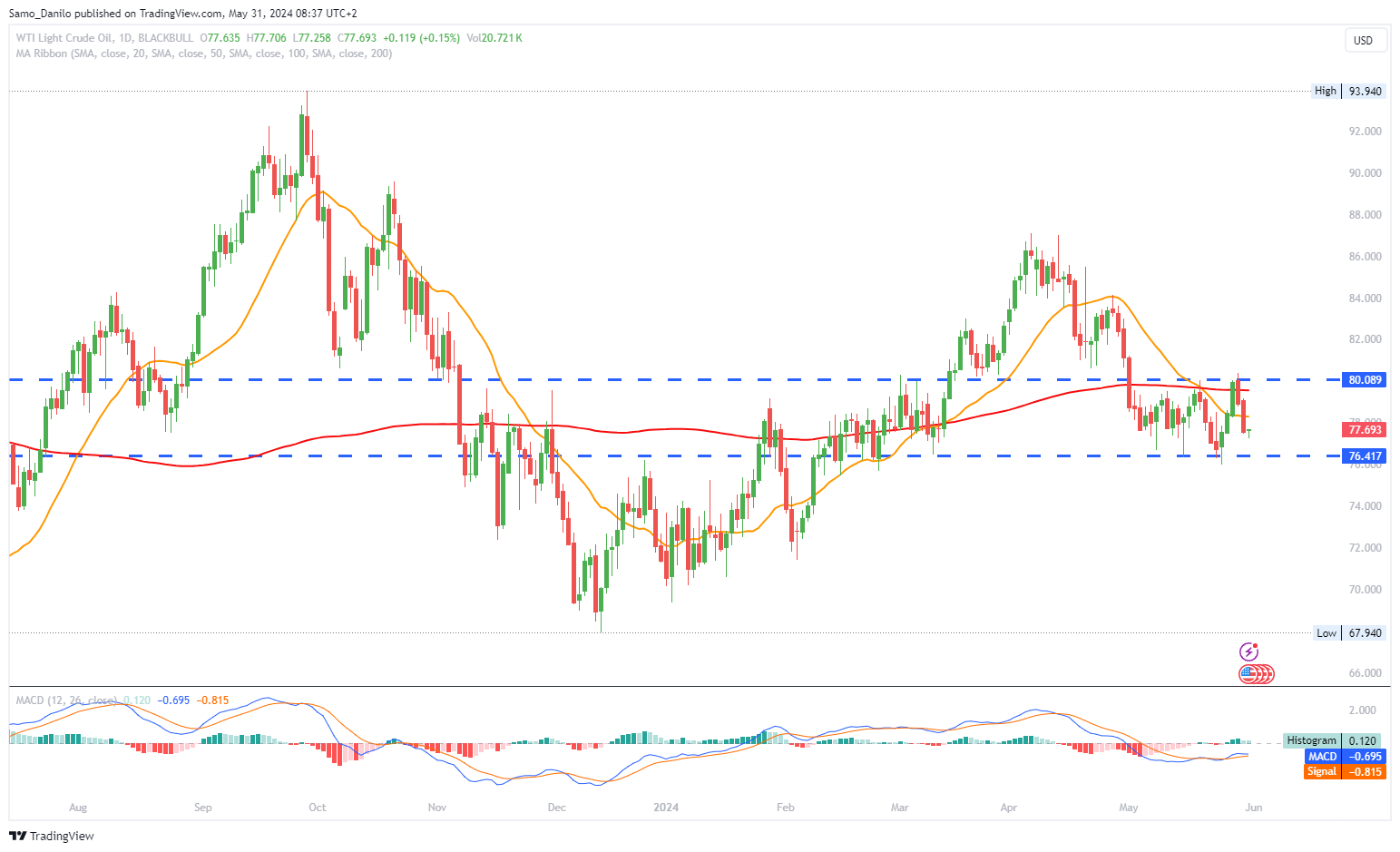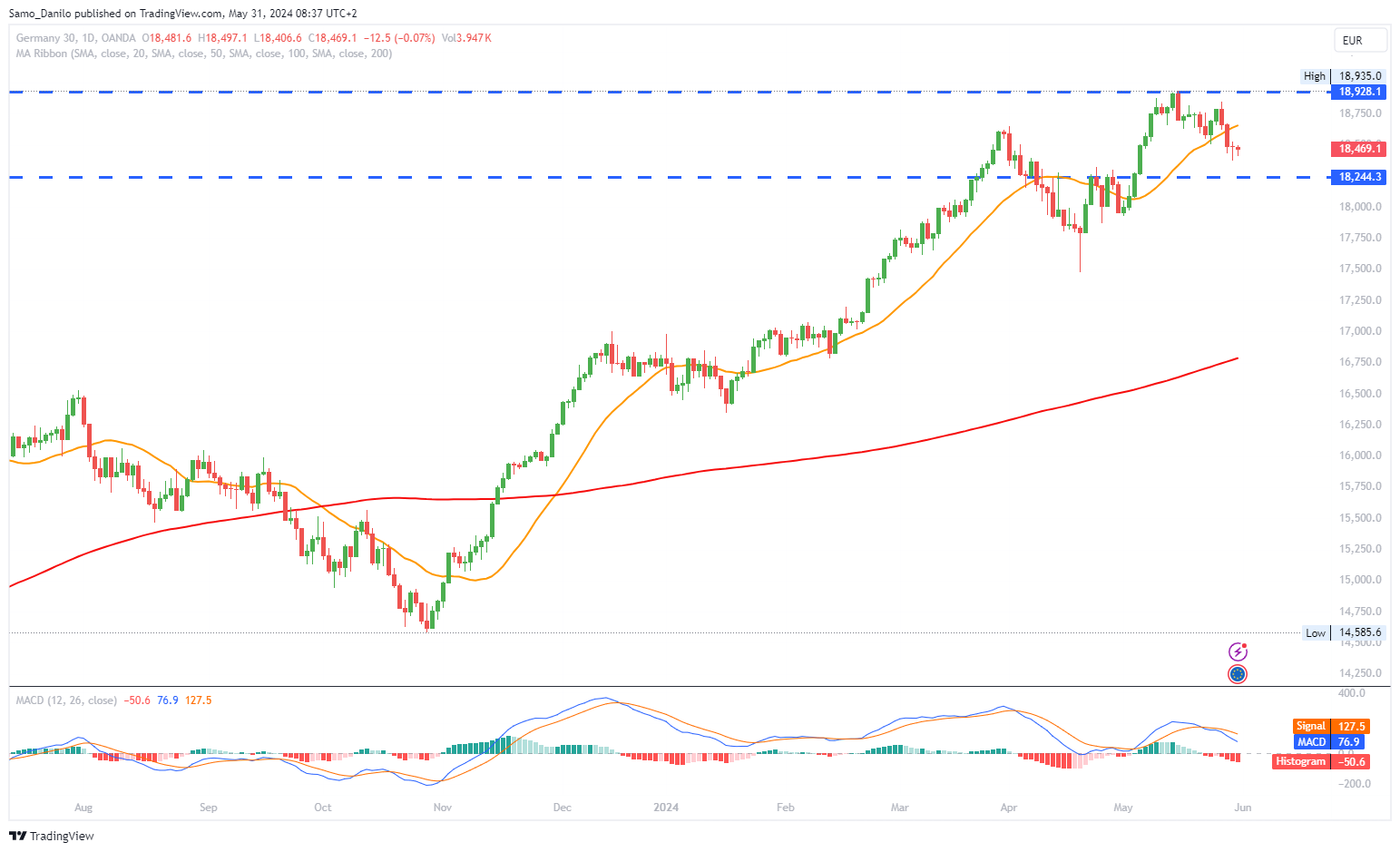EURUSD
- EUR/USD Weakens: The EUR/USD pair edges lower to 1.0820 during the early European trading hours on Friday.
- Technical Analysis: According to the technical analysis on the daily chart, EUR/USD has remained capped within a descending trend channel since mid-December 2023, although the major pair maintains a bullish sentiment.
- Eurozone Inflation Data: The Harmonized Index of Consumer Prices (HICP), a broad measure of inflation in the Eurozone, is set to be released on Friday, May 31. The European Central Bank (ECB) will closely analyze this inflation data amidst renewed doubts regarding the potential start of its easing cycle at its June meeting.
- ECB President Comments: In her previous comments on April 19, ECB President Christine Lagarde stated that Eurozone inflation is expected to decrease further, and that the ECB might reduce interest rates if its long-standing price growth criteria are satisfied.
- US Economic Data: Investors prefer to wait on the sidelines ahead of the US Core Personal Consumption Expenditures (PCE) Price Index data, which are due later on Friday.
Closing statement: The EUR/USD pair weakens to 1.0820 in early European trading on Friday, with the daily chart indicating a descending trend channel since mid-December 2023, yet maintaining a bullish vibe. The release of the Harmonized Index of Consumer Prices (HICP) in the Eurozone is highly anticipated, as the ECB analyses inflation data amidst doubts about starting its easing cycle in June. ECB President Christine Lagarde has suggested potential rate reductions if inflation continues to decrease. Investors are cautious ahead of the US Core PCE Price Index data, waiting for further economic indicators.
GBPUSD
- GBP/USD Edges Lower: GBP/USD edges lower near 1.2715 during early Friday, despite some selling pressure on the USD Index providing support to the major pair.
- US Economic Growth: The US economy grew at a slower pace than initially thought during the first quarter (Q1). The second estimate of US Gross Domestic Product (GDP) showed the economy expanded at an annualized pace of 1.3% in Q1, down from 1.6% in the previous reading.
- US Jobless Claims: The US weekly Initial Jobless Claims for the week ending May 25 rose to 219K from the previous week's 216K, exceeding the market consensus of 218K.
- Pending Home Sales: Pending Home Sales dropped to -7.7% MoM in April, a sharp decline from 3.6% in March.
- BoE Rate Expectations: The expectation that the Bank of England (BoE) will start cutting interest rates from the August meeting might weigh on the Pound Sterling (GBP).
| SMA (20) | Rising |
|
|
| RSI (14) | Slightly Falling |
| |
| MACD (12, 26, 9) | Rising |
|
|
Closing statement: GBP/USD edges lower near 1.2720 early Friday, supported slightly by selling pressure on the USD Index. The US economy grew at a slower annualized pace of 1.3% in Q1, down from 1.6% previously estimated, with weekly Initial Jobless Claims rising to 219K and Pending Home Sales dropping sharply to -7.7% MoM in April. Additionally, the anticipation of the Bank of England potentially cutting interest rates from the August meeting could weigh on the Pound Sterling.
GOLD
- Gold Price Under Pressure: Gold price is seeing fresh selling near $2,340, extending the previous decline early Thursday.
- Fed Commentary and Inflation Concerns: Recent hawkish Fed commentary and policymakers' concerns about persistent inflation have diminished the odds for aggressive Fed rate cuts.
- Market Pricing of Fed Rate Decisions: According to the CME FedWatch Tool, markets are pricing about 53% odds that the Fed will hold rates in September, while the probability of a November rate cut stands at around 60%.
- Geopolitical Tensions: Mounting tensions in the Middle East, which could escalate into a wider regional conflict, keep the risk-off flows intact, affecting gold prices.
- US Economic Data Focus: The focus remains on the second estimate of the Q1 US Gross Domestic Product (GDP) data, weekly Jobless Claims, and Pending Home Sales data, alongside speeches from New York Fed President John Williams and Dallas Fed President Lorie Logan.
| SMA (20) | Rising |
|
|
| RSI (14) | Neutral | ||
| MACD (12, 26, 9) | Falling |
|
|
Closing statement: Gold prices face fresh selling near $2,330 early Thursday, extending previous declines. Recent hawkish Fed commentary and concerns about persistent inflation have reduced the likelihood of aggressive rate cuts. Markets are currently pricing a 53% chance of the Fed holding rates in September, with a 60% chance of a rate cut in November. Mounting geopolitical tensions in the Middle East keep risk-off flows intact. Investors remain focused on upcoming US economic data and Fed speeches to gauge the future trajectory of monetary policy.
CRUDE OIL
- WTI Crude Oil Price Decline: West Texas Intermediate (WTI) crude oil continues its losing streak for the third consecutive day, trading around $77.70 per barrel.
- OPEC+ Discussions: According to Reuters, three sources familiar with OPEC+ discussions indicated on Thursday that the group is working on a complex deal to be agreed upon at its meeting on Sunday, potentially allowing OPEC+ to extend some of its deep oil production cuts into 2025.
- Fed Rate Hike Concerns: Hawkish remarks from Federal Reserve (Fed) officials have raised concerns about potential rate hikes, which negatively impact the US economic outlook and dampen crude oil demand.
- EIA Crude Inventory Report: The US Energy Information Administration (EIA) released its oil stockpiles report, indicating that US crude inventories declined by 4.156 million barrels in the week ending on May 24.
- Fed Inflation Concerns: On Thursday, Dallas Fed President Lorie Logan expressed continued concerns about upside risks to inflation despite recent easing, warning that the Federal Reserve needs to remain flexible and keep "all options on the table."
| SMA (20) | Falling |
|
|
| RSI (14) | Slightly Falling |
| |
| MACD (12, 26, 9) | Slightly Rising |
|
Closing statement: WTI crude oil continues its decline, trading around $77.70 per barrel for the third consecutive day. OPEC+ is working on a complex deal to extend deep oil production cuts into 2025, with a decision expected at its upcoming meeting. Hawkish remarks from Fed officials have raised concerns about potential rate hikes, negatively impacting the US economic outlook and oil demand. The EIA's recent report showed a decline in US crude inventories by 4.156 million barrels. Additionally, Dallas Fed President Lorie Logan highlighted ongoing inflation risks, emphasizing the need for the Fed to remain flexible in its policy decisions.
DAX
- Eurozone Unemployment Rate Decline: The Eurozone unemployment rate fell from 6.5% to 6.4% in April. Tighter labor market conditions could support wage growth, consumer spending, and demand-driven inflation.
- Economic Sentiment Index Improvement: The Economic Sentiment Index for the Eurozone increased from 95.6 to 96.0 in April, signaling an improving economic outlook.
- US Economic Growth and Consumer Spending: The US economy grew by 1.3% in Q1 2024 after expanding by 3.4% in Q4 2023. Corporate profits fell, with consumer spending trending lower, indicating a shift in economic momentum.
- Germany's Retail Sales Decline: Germany's Retail Sales dropped by 1.2% MoM in April, following a 1.8% increase in March, according to official data released by Destatis on Friday.
- Eurozone Inflation Impact on DAX: Higher-than-expected inflation figures for the Eurozone could significantly impact the DAX. Economists forecast the annual inflation rate to rise from 2.4% to 2.5% in April, which could diminish hopes of multiple post-June ECB rate cuts.
| SMA (20) | Rising |
|
|
| RSI (14) | Slightly Falling |
| |
| MACD (12, 26, 9) | Slightly Falling |
|
Closing statement: The DAX is navigating mixed economic signals as the Eurozone unemployment rate falls to 6.4% and the Economic Sentiment Index improves, indicating a positive economic outlook. However, the US economic growth slowdown and declining consumer spending signal a shift in momentum. Germany's retail sales dropped in April, adding to the economic concerns. Investors are closely watching Eurozone inflation figures, as higher-than-expected numbers could dampen expectations for post-June ECB rate cuts, potentially impacting DAX performance.
